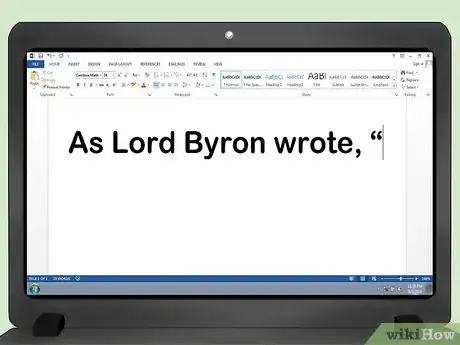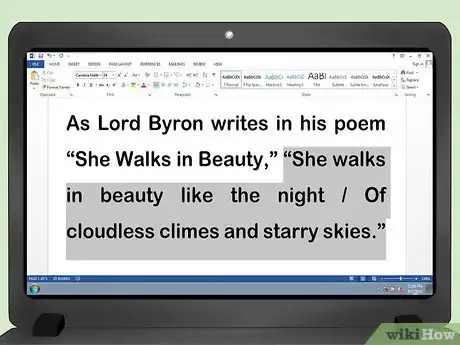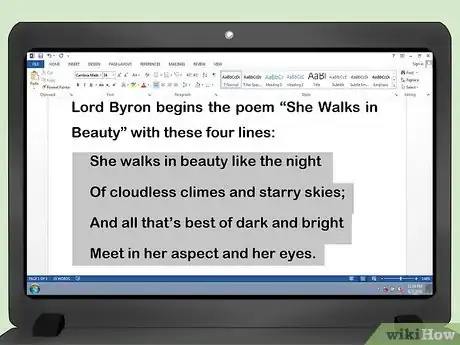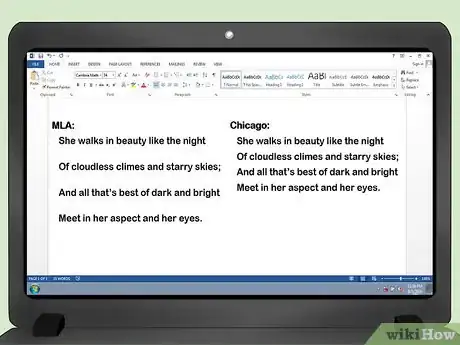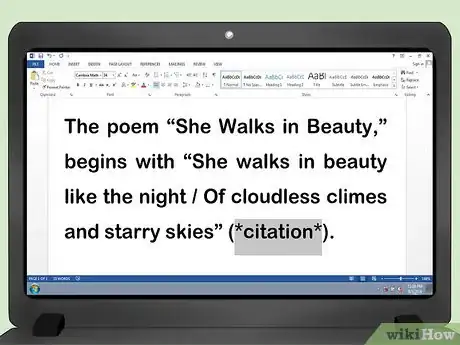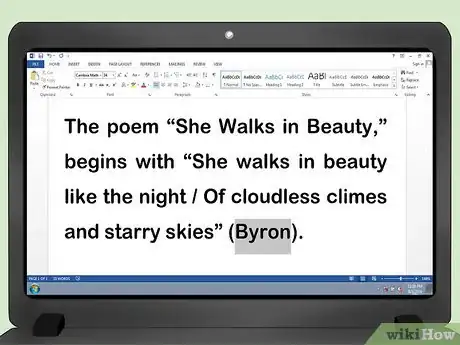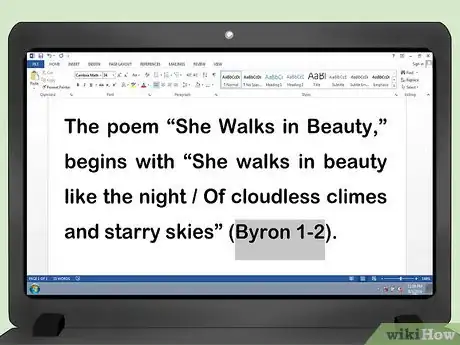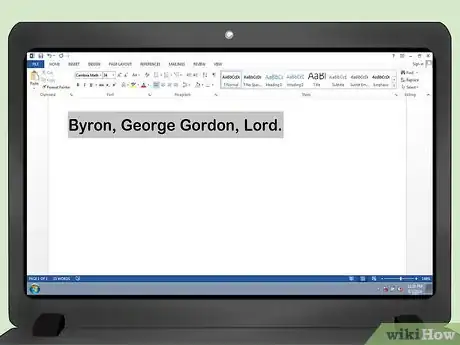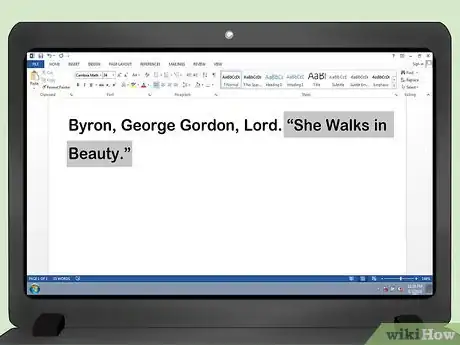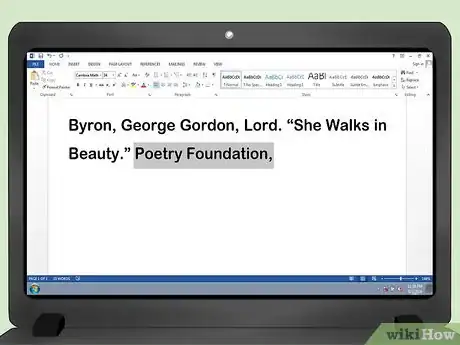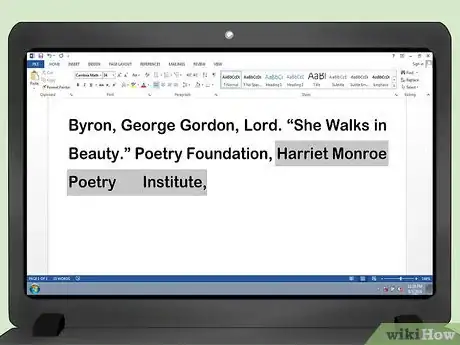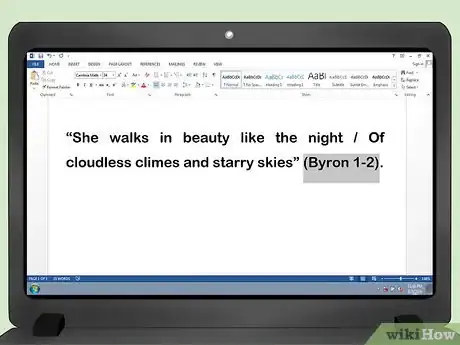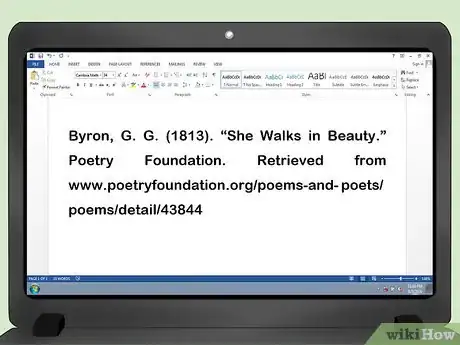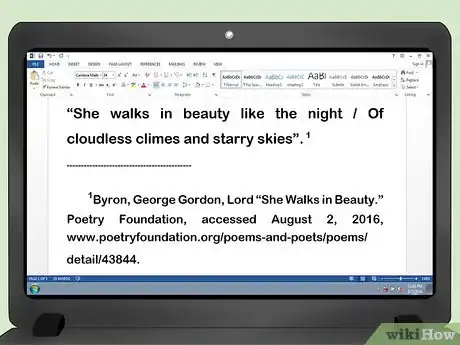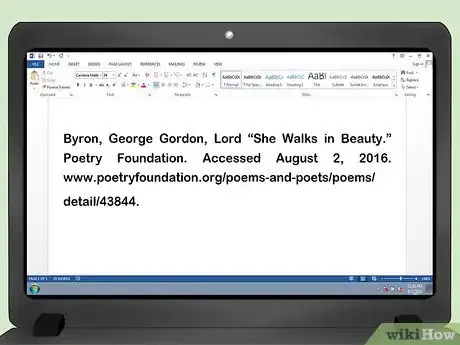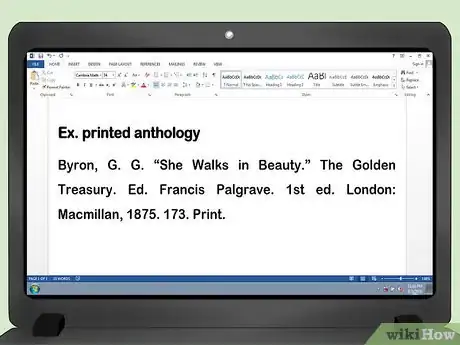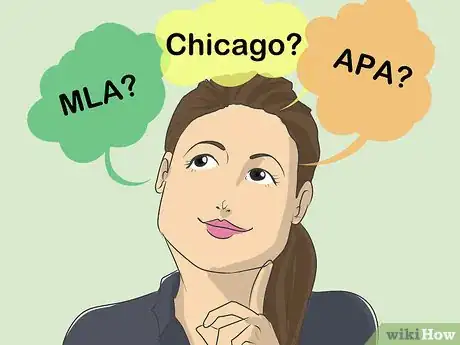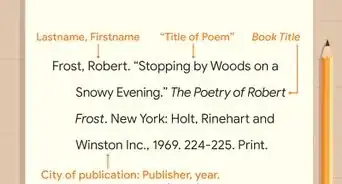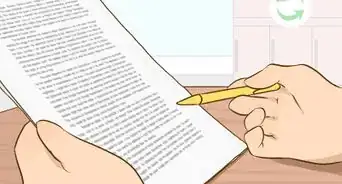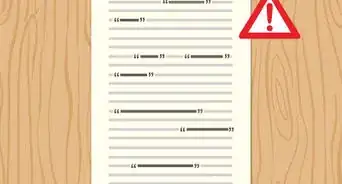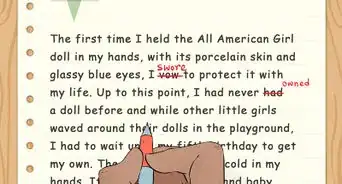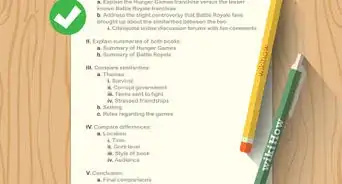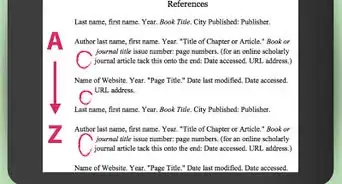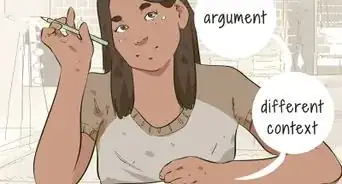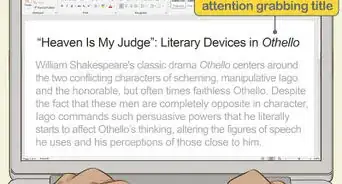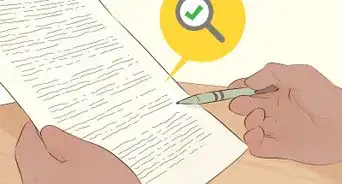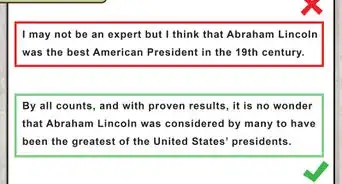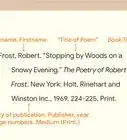This article was co-authored by Michelle Golden, PhD. Michelle Golden is an English teacher in Athens, Georgia. She received her MA in Language Arts Teacher Education in 2008 and received her PhD in English from Georgia State University in 2015.
There are 10 references cited in this article, which can be found at the bottom of the page.
This article has been viewed 61,496 times.
Quoting poetry in your writing is a bit trickier than quoting prose. Because poetry is stylized a certain way, you try to maintain that style for your readers, though how you maintain the style differs according to whether you're using a short quote or a longer quote. After you quote parts of a poem, you'll also need to create an in-text citation and an end reference for the poem to show your readers where you found the information. The most common style to use for citations in literature essays is the style from the Modern Language Association (MLA), though you may also need to use Chicago or American Psychological Association (APA) style.
Steps
Quoting Long and Short Passages
-
1Start by introducing the quote. When you're using a quotation in an essay, you can't just throw it out there without providing some introduction, with the exception of epigraphs. You need to provide context for the quote, even if it's just the author's name.[1]
- For instance, you could introduce your quotation in this way: As Lord Byron wrote, "...."
- Epigraphs are short quotations that go at the beginning of a paper or heading, that sort of introduce your reader to the topic of your paper.
-
2Add slashes for shorter quotes. A short poetry quote is considered anything three lines or shorter. That's three lines of the poem, not three lines in your paragraph. When the quote is this short, you use slashes to indicate where the line breaks are.[2]
- So if you're using the first two lines of Lord Byron's poem "She Walks in Beauty," it would look like the following quotation: As Lord Byron writes in his poem "She Walks in Beauty," "She walks in beauty like the night / Of cloudless climes and starry skies."[3]
- Note that you add a spaces around the slash.
Advertisement -
3Indent long quotes two spaces. When you are quoting four or more lines from a poem, you should use a block quote, which means you set the quote off from the rest of the text. Once you have your intro phrase, hit the return or enter key to start the quotation. Then, indent the whole quote by two spaces.[4]
- When making a longer quote, it's better to introduce it with a full sentence and a colon rather than a phrase. Also, you don't use quotation marks with a block quote.
-
4Keep the spacing consistent. For MLA style, you will need to maintain double spacing for your entire paper, including the lines from the poem you include. In Chicago style, you use single spacing for the actual block quote and double spacing for the area around the block quote and the rest of the paper.
- For MLA style, a long quote from Byron's poem would follow this format:
Lord Byron begins the poem "She Walks in Beauty" with these four lines:
She walks in beauty like the night
Of cloudless climes and starry skies;
And all that's best of dark and bright
Meet in her aspect and her eyes.
- For MLA style, a long quote from Byron's poem would follow this format:
-
5Add ellipses to show you've removed words. If you've removed part of the quotation, you need to show that something is missing. The way you do that is with ellipses, which is just three dots in a row. You use the ellipses in place of what you've removed.[5]
- For example, if you wanted to take "in beauty" out of the first line of Byron's poem, it would look like the following quotation: "She walks ... like the night / Of cloudless climes and starry skies."
-
6Incorporate the quote into your argument. When you're performing literary analysis on a poem, you use quotations to back up the argument you're making about the writer. Otherwise, you don't need the quotation. Therefore, when you make a quotation, move on to talk about why you used it.
- For example, if you quoted the first two lines of Byron's poem, you could use it to talk about Byron's use of similes.
Creating an In-Text Citation in MLA Style
-
1Envelope the citation in parentheses. At the end of the quotation, you'll use parentheses to enclose the citation. In a short quotation, the citation goes after the end quotation mark but before the period. In a long quotation, it goes after the period.[6]
- For a short quote, use this format: As Lord Byron writes in his poem "She Walks in Beauty," "She walks in beauty like the night / Of cloudless climes and starry skies" (citation).
- Follow this example for a blockquote:
Lord Byron begins the poem "She Walks in Beauty" with these four lines:
She walks in beauty like the night
Of cloudless climes and starry skies;
And all that's best of dark and bright
Meet in her aspect and her eyes. (citation)
-
2Decide if you need to include the author’s name in the citation. If your entre paper is about the poem, then you do not need to include the author’s name in the in-text citations. However, if you are writing about two or more poems, then you will need to include the author’s name in the sentence or in-text citations. If you don't introduce the quote with the author's name, then you can place the name in the citation. It will follow the open parenthesis without a space as the beginning of the citation. Just use the last name of the author followed by the line numbers. If you did use the author’s name in a sentence, then just provide the line numbers.[7]
- Add the name in like the following quote: The poem "She Walks in Beauty" begins with the following lines: "She walks in beauty like the night / Of cloudless climes and starry skies" (Byron 1-2).
- If the poem is anonymous or uncredited, such as “I Eat My Peas with Honey,” then use a shortened form of the title: ("I Eat" 1-2)[8]
-
3Add the line numbers you used. The other part of the citation is to include the line numbers of the poem you cited. For instance, in the short quote example, the first two lines of the poem are cited, so you note that you used line one and two.[9]
- Follow this example: The poem "She Walks in Beauty" begins with the following lines: "She walks in beauty like the night / Of cloudless climes and starry skies" (Byron 1-2).
- If you skip a line, use a comma to separate the the numbers. For instance, if you use lines 1 and 3, it would look like this example: (Byron 1, 3).
Creating an End Reference in MLA Style
-
1Begin with the author of the poem. A citation usually begins with the author or editor's name. In this case, the author's full name is Lord George Gordon Byron. Start with the last name, followed by the first and middle. In this case, you'll include the "Lord" after his other names since that's how he's commonly known, but you don't usually include titles.[10]
- The beginning of the citation would follow this format: Byron, George Gordon, Lord.
- If the poem's author is anonymous, start with the title of the poem.
-
2Add the title of the poem. The title of the poem comes next, as it is what MLA calls "the title of source" in the 8th edition. Put the title in quotation marks. Also, follow the title with a period before the end quotation mark.[11]
- Continue the citation in this manner: Byron, George Gordon, Lord. "She Walks in Beauty."
- Be sure to capitalize important words in the title.
-
3Place the title of the container next. The container is where you found the poem. It could be a book, such as an anthology of poems. It could also be a website or even a scholarly journal. It doesn't matter. You just need to cite where you found the poem, usually using italics.
- The citation would continue in this way, since this poem is from the Poetry Foundation: Byron, George Gordon, Lord. "She Walks in Beauty." Poetry Foundation,
-
4Add other contributors, the volume, and the issue. Normally, you also add information like other contributors, the volume, and the issue number, if its applicable. If it's not, as it is in this case, you leave it out. Place commas in between the information if it is included.
- This particular citation has none of these attributes, so leave them blank.
-
5Use the publisher. If the poem you used has a publisher, you add it next. In the case of a website, the publisher is sometimes the same as the website but not always. If it's the same, you only need to place it once. In other cases, you'll find the publisher on the back side of the title page.[12] In this case, the publisher is the Harriet Monroe Poetry Institute.
- Here's how the citation looks so far: Byron, George Gordon, Lord. "She Walks in Beauty." Poetry Foundation, Harriet Monroe Poetry Institute,
-
6Cite the date. Next, the citation uses the date. The date is the publication date, the year. You use a comma to separate it from the publisher. However, in the case of a website, you don't need to add a date. You can add the date you accessed it if you wish.
- If you were to add a date, it would look like the following citation: Byron, George Gordon, Lord. "She Walks in Beauty." Poetry Foundation, Harriet Monroe Poetry Institute, 2 August 2016,
-
7Add the location. The location is the page numbers where you found the poem in the collection. For example, you may have found the poem on page numbers 66 to 68, which you'd write this way: pp. 66-68. However, in this case, the "location" is the web address where you found the information.
- Here's the final citation: Byron, George Gordon, Lord. "She Walks in Beauty." Poetry Foundation, Harriet Monroe Poetry Institute, www.poetryfoundation.org/poems-and-poets/poems/detail/43844.
- Don't add "http://" or "https://" before the web address.
Creating References and In-Text Citations in Chicago and APA
-
1Format an in-text citation in APA. As noted, you'll sometimes need to use other citation styles when quoting poetry. For example, though APA is generally used in the sciences, you may need to use APA style to quote poetry in some essays. For an in-text citation, the style is much the same as MLA.
- For example, with APA, the in-text citation would appear this way: "She walks in beauty like the night / Of cloudless climes and starry skies" (Byron 1-2).
- Just like MLA, you'll use the author's name and line numbers. However, if the poem doesn't have line numbers, you can just use an abbreviation of the title: (Byron "She Walks").
-
2Style your reference properly in APA. In APA, the date is given preference over the title because the style is used more often in the sciences. Therefore, more recent publications have more weight than older research. Of course, the same is not true for poetry, as older poetry has equal merit with contemporary poetry, but you still must give the date preference in the reference. If the source doesn't have a date, as is often the case with online documents, you'll use "n.d." for "no date." Otherwise, you'd use the year in the parentheses.[13]
- For APA, use this format with the example from throughout this article: Byron, G. G. (1813). "She Walks in Beauty." Poetry Foundation. Retrieved from www.poetryfoundation.org/poems-and-poets/poems/detail/43844
- Note that APA uses initials rather than full first and middle names. This structure is in place to discourage gender bias.
-
3Format an in-text citation in Chicago. Chicago is most often used in history and religion, though it can be used in other disciplines as well. It differs from MLA and APA in that you'll use a footnote rather than a typical in-text citation. A footnote places a number in the text that refers to a citation at the bottom of the page. You can insert a footnote with most word processing software.[14]
- In this case, the footnote would look like the following example: 1. Byron, George Gordon, Lord, "She Walks in Beauty," Poetry Foundation, accessed August 2, 2016, www.poetryfoundation.org/poems-and-poets/poems/detail/43844.
- You can also add a publication date ("Last modified July 2, 2016,") before the access date.
-
4Style your reference in Chicago. Chicago's reference style is similar to its footnote style, with the exception that much of the punctuation changes. It is also more similar to MLA than it is to APA, as it focuses more on humanities than sciences.[15]
- For Chicago, use this format: Byron, George Gordon, Lord. "She Walks in Beauty." Poetry Foundation. Accessed August 2, 2016. www.poetryfoundation.org/poems-and-poets/poems/detail/43844.
- Once again, you can add a publication date ("Last modified July 2, 2016,") before the access date if it has it.
-
5Base your citation on the format where you found the poem. While the citation examples used here focus on website citations, you may find a poem in other places, such as an anthology. In that case, you use the citation style for an anthology, not a website.
-
6Choose a style based on your discipline or teacher's preference. Generally, you will use the same style for all the professors in your discipline. If you're not sure which one to choose, ask your teacher, check your syllabus, or review your assignment. Most teachers will tell you which style you need to choose. Sometimes, one style is chosen for a whole school, in which case you need to check the student handbook or ask your teacher to determine the style.
- If you need more information on these styles, review the MLA Handbook, Eighth Edition; The Chicago Manual of Style, 16th Edition; the Publication Manual of the American Psychological Association, 6th Edition; or Purdue's Online Writing Lab (OWL), which has information on all three.
References
- ↑ http://www.georgetowncollege.edu/eng/resources/how-to-quote-poetry-in-english-papers/
- ↑ https://owl.english.purdue.edu/owl/resource/747/03/
- ↑ https://www.poetryfoundation.org/poems-and-poets/poems/detail/43844
- ↑ http://www.georgetowncollege.edu/eng/resources/how-to-quote-poetry-in-english-papers/
- ↑ http://www.georgetowncollege.edu/eng/resources/how-to-quote-poetry-in-english-papers/
- ↑ https://owl.english.purdue.edu/owl/resource/747/03/
- ↑ https://owl.english.purdue.edu/owl/resource/747/03/
- ↑ https://www.poetryfoundation.org/poems/42908/i-eat-my-peas-with-honey
- ↑ http://www.georgetowncollege.edu/eng/resources/how-to-quote-poetry-in-english-papers/
- ↑ http://www.math.grinnell.edu/~simpsone/Connections/Writing/Quote/quote2.html
- ↑ https://owl.english.purdue.edu/owl/resource/747/22/
- ↑ https://www.easybib.com/guides/citation-guides/mla-8/mla-7-vs-mla-8/
- ↑ https://owl.english.purdue.edu/owl/resource/560/10/
- ↑ https://owl.english.purdue.edu/owl/resource/717/05/
- ↑ https://owl.english.purdue.edu/owl/resource/717/05/
